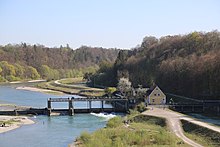Isar works canal



The Isar-Werkkanal is a side canal of the Isar in the urban area of Munich. It follows the Isar to the west for a length of about 12 km, can absorb up to 70 m³ / s and is mainly used to generate energy.
history
Towards the end of the 19th century, the private Isarwerke built two hydropower plants on the Isar south of Munich: the Höllriegelskreuth hydropower plant in 1894 and the Pullach hydropower plant in 1900 . To operate these power plants, some of the water from the Isar was diverted into a works canal near Buchenhain . Shortly above the Großhesseloher bridge this canal flowed back into the Isar. Parallel to the construction of the works canal, the Isar was regulated in this section of the route.
When the city of Munich built the Isarwerk 1, the first municipal hydroelectric power station, on the Isar from 1906–1908 , the works canal was extended to the Thalkirchner Bridge and there it was fed back into the Isar. Here, too, the Isar was regulated in the corresponding section of the route. The raft canal , which had previously branched off from the Isar , was now fed by the Werkkanal and also flowed back into the Isar at the Thalkirchner Bridge. The plans for this expansion led to the establishment of the Isar Valley Association in 1902, which campaigned for the preservation of the natural river landscape. Even if the construction of the canal could not be prevented by this, its course was corrected and, after the construction work was completed, the river landscape was recultivated. The then city gardening director Jakob Heiler had a park-like alluvial forest and the Hinterbrühler See created .
For the construction of the two hydropower plants Isarwerk 2 and Isarwerk 3 from 1921 to 1923, the canal was extended again. It was introduced into the bed of the large city stream , which originally drew its water from the Isar during the Thalkirchen raids and fed the Munich city streams .
course
The canal is diverted from the Isar near Buchenhain in the Munich district . After the Höllriegelskreuth and Pullach power plants , which belong to E.ON , the canal becomes the property of Stadtwerke München . A little south of the Großhesseloher bridge there is a weir in which water can be channeled from the canal into the Isar and vice versa. The municipal utilities then operate the Isarwerk 1 , Isarwerk 2 and Isarwerk 3 run-of-river power plants . From Isarwerk 2, the canal follows the original course of the Große Stadtbach . At the Braunau railway bridge south of the city center, a large part of the water flows back into the Isar behind Isarwerk 3. Only a small part is branched off, drives the Stadtbachstufe and flows on as the Westermühlbach .
Fish death
In October 2018, after repair work on the works canal, fish died in the Isar, with up to a hundred thousand fish perishing because the water level in the Isar fell too quickly due to the water being drawn off for the works canal.
Other use
On a section of the canal, the rafts, which are used as a leisure attraction, travel to the raft landing area from Wolfratshausen . This is reached via a raft canal that branches off from the canal above Isarwerk 1. About 400 m below Isar Plant 1, the canal supplies the Auer Mühlbach on the eastern side of the Isar with water via a culvert running under the Isar . Shortly below the Thalkirchner Brücke, the Maria-Einsiedel-Bach , which is fed from the overflow of the raft land, flows back into the Werkkanal. The canal is also used to supply the cooling water to the southern thermal power station of the Munich municipal utility .
Web links
Individual evidence
- ↑ Johanna Deckers, Veronika Beer: Up to a hundred thousand fish died in the Isar. In: br.de . October 10, 2018, accessed May 6, 2019 .